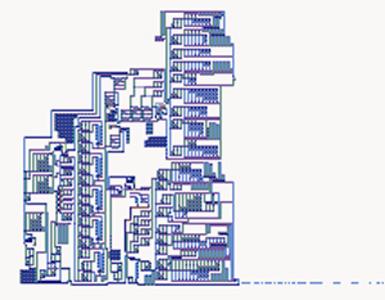“Extraterrestrial Intelligent Beings Do Not Exist.”
– Frank Tipler
Von Neumann Machines… Clanking Replicators… Universal Constructors… They are one of the many fascinating dimensions of speculation concerning Fermi’s Paradox, which posits the question: If there is life in the Universe, then why don’t we see it?
 The Nobili-Pesavento 29-state approximation ofvon Neumann’s universal constructor, with a tape of instructions extending to the right. |
Named after John von Neumann, who established the mathematical laws of self-replicating systems, the concept of Von Neumann Machines (VNM’s) is meant to reinforce this paradox. A VNM is a theoretical replicating probe that, given the age of our Universe, should populate all the solar systems in our galaxy. The idea is that, even using the worse case scenarios calculable through the Drake Equation, thousands if not millions of advanced civilizations should have come and gone by now in just our own galaxy. In the interest of colonization, one of them should have invented a self-replicating probe that can migrate from solar system to system, multiply, and inhabit every suitable planet in the galaxy.
This makes sense if we look at our own planet and its species. The human race has multiplied and migrated to every corner of our planet and even the local space. We have sent probes to the edge of our solar system and beyond, we have a bubble of television transmissions with a radius of nearly 60 light-years expanding from our planet, and we have accomplished this within just a few millennia of forming civilization and just 50,000 years of migrating out of Africa.
If the dinosaurs were not driven to extinction, it would not be unreasonable to think their evolutionary progeny would have evolved tool use, intelligence, civilizations, and space travel too–65 million years before the present. Take this thinking further, to the Permian-Triassic mass extinction 251 million years ago, and we can imagine their ancestors accomplishing the same. Take this thinking to other systems, where Earth-like worlds formed 1,000 million years before our own, and we quickly realize how plentiful advanced life should be in our galaxy and wonder why we are not seeing it.
In the case of Von Neumann Machines, we wonder why we are not seeing the byproduct of advanced civilizations. With the apparent mathematical probability of advanced extraterrestrial life in just our galaxy alone, there must be some reason why we don’t see evidence of their existence, which would cause a revolutionary iconoclasm of thought in our planetary civilization.
This speculative exercise is useful for providing insight into the nature of our reality, if lacking any practical application to it. So I wonder, how difficult would it be to build a von Neumann probe?
These are the requirements I could think up. I’m sure in a Universe as complex as ours, there are a bazillion other criteria I can’t imagine. I tried to keep them simple; however the answers can become incredibly complex.
1. A Power Source.
VNM’s, like everything else that gets around intentionally, require energy to do so. Unless our Advanced Ancient Aliens have found a way around Newtonian Physics (or Zorkonian Physics, as they may have known them), and have equipped their VNM’s with a perpetual motion engine, they’re VNMs are going to need a fuel source. Solar and gravitational energy sources don’t appear ideal because starlight and gravity are vary throughout the galaxy, waning down to a miniscule resource in the vast empty spaces between stars.
So the VNMs must process a fuel source that they can carry with them: hydrogen, Uranium, or some other heretofore unknown form of matter that can be converted into energy. But not just any form of matter. It must be a form of matter found in abundance throughout the galaxy, especially on whatever planet our VNM lands on and decides to call home.
2. A Means of Propulsion.
Our VNM must be able to get off world, and it must be able to push in the direction of the next world. It needs a means of hurtling itself through space to the next system. If it has enough time, it can ride solar winds to the next star system, but it will still need a means to lift itself out of a planet’s gravitational pull.
Actually, our VNM will need many different means of propulsion. It must be able to walk on land, fly in the air, and swim in the seas in addition to jumping from planet to planet and solar system to system. It needs legs, wings, fins, and rocket boosters to make it truly effective as a Universal Constructor. It must be the deluxe Swiss army knife off replicating machines.
3. Adaptability
Allow me to further clarify my last point: Our VNM must be able to walk on many different types of land, fly in many different types of atmospheres, and swim in many different ocean consistencies. We all know and love Earth’s atmosphere, ocean, and landscapes, but our VNM must be able to work on Saturn’s moon Titan’s thick atmosphere and methane oceans as well as Venus’ acidic atmosphere and semi-liquid landmass.
The universe is filled with wondrous diversity. No single life form/robot could hope to survive on all types of planets. A robot that could roam Europa’s ice sheets would sink through Venus’ semi-liquid surface. If it could glide through Jupiter’s atmosphere, it would fall flat to the surface of winter-time Pluto’s atmosphereless environment.
That’s just in our solar system, which lies at the edge of our galaxy. Moving towards the center of our spiral disk, the Clanking Replicator would encounter an environment saturated with heat and radiation. Look at how much difficulty we have keeping satellites functioning in orbit around our planet? Solar radiation, temperature extremes, and orbital debris are constantly wiping out our network of machines serving us from space. Our VNM must be nigh invincible, or have some other trick up its sleeve, to populate such an unfathomable variety of environments.
4. Intelligence.
Even being stupendously-invulnerable and stupefyingly-adaptable, our VNM would need to be able to identify nearby planets/hostile environments to some degree. It would at least need to be able to look up into the night sky and figure out where to send its offspring. If happened to be residing on a planet with perpetual cloud-cover, it would need to have a databank profiling potential destinations. Since our galaxy is so complex as to be chaotic system lacking predictability, the VNM would need the intelligence to perpetually update that catalogue.
Our VNM would need the intelligence to circumvent black holes, predict and avoid super-novas, identify planets with the natural resources to reproduce and power its functions, and use its adaptability and various propulsion systems at the appropriate times and circumstances. In other words, it would have to be pretty damn smart.
5. Digital Replication.
Finally, because the purpose of a VNM is to colonize the Universe, it must reproduce. Everywhere a VNM probe sets down, it must take the raw materials it finds there and produce more VNM probes. It must build these new probes perfectly. If a flaw entered one of the VNMs, it might replicate to successive generations and the whole colonization process would stop. The VNM must have a flawless means of reproducing the vast complexity we have outlined in the preceding requirements.
In Summary: Our Clanking Replicator must have an incredible power source, a means of propulsion to get it between planets, solar systems, and galaxies, it must have the potential to adapt to any possible environment the universe can throw at it, the intelligence to foresee potential problems and avoid hazards, and the ability to replicate itself perfectly out of common materials found everywhere in the Universe.
No big deal, right? Ha! Ha!
This brings us to the sixth criteria for our Universal Replicator: a civilization advanced enough to construct such a fantastic device. They would need to have fantastic technological powers and a scientific understanding of our universe far beyond our muddled view of reality. They would have to be absurdly, ridiculously, nonsensically, mind-bafflingly and mind-bogglingly advanced. I mean really really really really really advanced. Got it?
So with all that, why would they want to make a wind up toy to colonize the Universe? What would they have to gain from such an unimaginable investment of energy and resources?
Suppose they did build this infinitely-adaptable and nigh-invincible machine with a superior intelligence for getting around the universe. Why would the VNM want to pursue colonization? If it’s that smart, wouldn’t it quickly come to the same conclusion as its inventors and say, “Screw this colonization stuff, I’m gonna build a telescope so I don’t have to make the trip (or build a probe to explore remotely, ponder my navel, or play Nintendo (or Zorktendo, as the VNM may have)).”???
Maybe the AAEC (Absurdly Advanced Extraterrestrial Civilization) actually did build VNMs. Maybe we find these Universal Constructors all around us and we just don’t know it because we lack the ability to prove their origins.
Is it possible that Viruses, Archaea, Bacteria and Eukaryotes are Replicating Probes?
 Bacterial Morphology |
They are found in every environment on Earth, even the most extreme. They employ a variety of methods to obtain energy from their environment–Oh heck, Wikipedia says it better:
Bacteria are ubiquitous in every habitat on Earth, growing in soil, acidic hot springs, radioactive waste, seawater, and deep in the earth’s crust. Some bacteria can even survive in the extreme cold and vacuum of outer space (source).
The simple microscopic are the most ultimately adaptable organism. They appeared on Earth and immediately began evolving into higher life forms.
Not bacteria precisely, but Eukaryotes evolved into the plant and animal kingdoms. Although the two exist on different branches of the evolutionary web of life, evidence suggests they both originated from Protobionts for which we are still reverse-engineering the process of how inanimate molecules formed replicating molecules.
DNA is digital replication. Mutations occur very rarely, preserving the biological models that emerge, but apparently mutate with enough frequency to introduce novel biological models that test and challenge the preceding models.
These simple models adapt successfully to the planet they land on, evolving to consume whatever materials they can turn into energy and reproduce themselves. They fill every niche on the planet, and eventually evolve intelligence, the most adaptable trait of all.
The only factor missing is the propulsion, but they might hypothetically use the natural flow of our galaxy to migrate between worlds. Found in the Earth’s upper atmosphere, they are regularly blown away into space, catching a ride on the solar winds to the outer planets. They could also possibly hitch a ride on a comet to land with life-sustaining water on another planet in another solar system.
Or maybe it would just hitch a ride with it’s younger, however more evolved siblings. A human astronaut landing on Europa leaves a dusting of microscopic organisms and one of them manages to survive. This interstellar panspermia eventually becomes a colony that is the foundation for evolving more Universal Constructors to fill the Universe.
“Hey guys! Remember that rest stop we made on the third planet from that star on the edge of the galaxy when we were vacationing 3 billion years ago? Guess what it turned into!”
For further speculations on Von Neuman Machines, I recommend an essay forwarded by one of my readers, Alexander Popoff, “The Hidden Alpha,” which got my mind wrestling with the topic.
I also recommend Greg Bear’s The Forge of God and Anvil of Stars books, which chronicle a fictional invasion of Universal Constructors that attack Earth.
Comments
One response to “Are We Von Neumann Machines?”